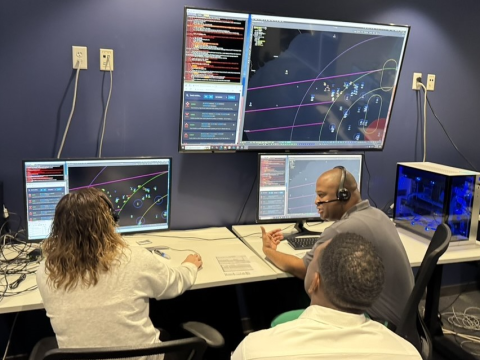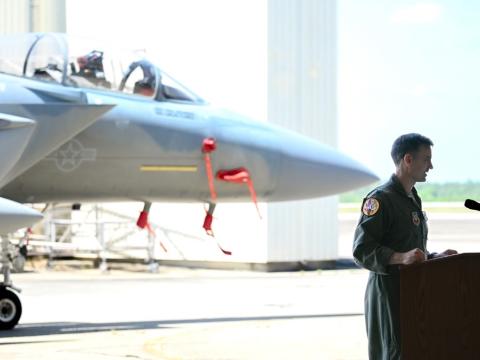Air Force Comes to Grips With Cyber
Roles are changing as the service reshapes its digital future.
The U.S. Air Force is subjecting itself to a cyber reality check with an eye toward restructuring the discipline both operationally and organizationally. A working group is parsing the service’s activities in this domain, and this effort involves interaction with the other services as well as the commercial sector.
The restructuring drive is being conducted in concert with other Defense Department changes across the realm of cyber activities. For the Air Force, it includes a shift from communications specializations to a cyber emphasis. Disparate disciplines are overlapping and may be combined. Some traditional Air Force career tracks even may serve as a model for training and promoting new cyber experts.
“We are hard at work trying to define what the Air Force future is in cyber,” says Gen. William L. Shelton, USAF, commander of the U.S. Air Force Space Command. “We are pulling the experts together from government and industry, trying to understand what this future looks like—what we need to build to. Rather than being confined by the past, we instead look ahead and try to determine what our cyber future looks like and how we need to posture ourselves to be much better in the cyber domain than we are today.”
The Space Command has the major command responsibilities for both space and cyberspace in the Air Force. This includes serving as core function lead integrator for both domains, so it is taking the lead in setting the scene for the Air Force in cyber.
This scene envisions the operational community being in charge of cyber operations, with the information technology community working on communications issues. A more efficient architecture with greater commercial involvement will enable a more secure mission-assurance focus in how the Air Force carries out its missions, the general suggests.
“We need to be very smart about how we spend our resources,” he emphasizes. “We don’t have a penny to waste at this point in time, so we want what would give us the most efficient use of the meager resources we have and how will it give us the most bang for the buck.” The overall goal is a more streamlined organization with “clearly identified lanes in the road,” Gen. Shelton adds.
“We need to normalize the way we do business in the cyber domain, because this has grown up as disparate networks and, often, end-of-year funding,” he declares. “We really don’t even have the good sustainment models built in for our cyber capabilities.
.jpg)
“It comes down to how does the Air Force want to see itself in the future in cyber?” Gen. Shelton asks. “Do we want to have a full-spectrum capability—have offense, defense, exploitation capability—or do we want to secure just our portion of the overall Joint Information Environment [JIE] and [leave] the higher-end capabilities to the U.S. Cyber Command? Those are questions that we all are going to wrestle with for the next couple years.”
The Air Force, along with the other services and the Joint Staff, are engaged in ongoing conversations with Cyber Command (CYBERCOM), the general notes. This is a concept that will continue evolving for at least the next couple of years. Legal and policy issues must be settled as part of this evolution.
A cyber working group in Air Force Space Command headquarters is at the heart of the service’s efforts to master cyberspace. This group is working with Air Force headquarters on both the operations side and the communications side. Its goal is to define resource requirements, operational objectives and architectures. “It runs the gamut … to make sure we are making the right decisions and going down the right, and most efficient, paths in the cyber future,” Gen. Shelton states.
This will entail fundamental decisions about how the Air Force wants to build its forces for the future, and these decisions touch on the entire U.S. military. For example, Gen. Shelton offers, CYBERCOM ultimately may evolve to either an organizational concept with centralized control and execution or it may have more of a decentralized execution. How the services work with CYBERCOM, which will be determined by the command, will influence the Air Force’s cyber future.
Within the Air Force, the working group is involved actively with the A-2, the A-3/5, the Intelligence, Surveillance and Reconnaissance Agency, the Air Force Network Integration Center (AFNIC), the 24th Air Force and the Space Command. “We are having some healthy disagreements, but at the end of all this we are going to be much stronger in the cyber domain because we will have worked through some really challenging questions,” Gen. Shelton says.
Part of this endeavor includes the Air Force migration to a single unclassified network (see page 57). The single architecture emerging from this network consolidation thrust will enable better security, the general offers. “Getting down to that single integrated network, which we can defend much easier and over which will have much greater situational awareness, is our number one priority,” he says.
First and foremost among these efforts is to determine proper roles and responsibilities, especially with regard to other cyber elements within and outside of the Air Force. The Air Force must ensure it is using proper definitions and doctrine in its cyber operations. Once these basic foundational blocks are properly defined, then the service can progress in other areas, Gen. Shelton notes.
The reshaping of Air Force cyber must be an enterprise approach that encompasses the entire realm, not one that is undertaken base-by-base or command-by-command, and the governance process for enforcing these standards must be very strong, the general emphasizes. He adds that ultimately, this Air Force enterprise must be a joint enterprise.
Many cyber challenges facing the Air Force are common across the military as a whole, Gen. Shelton allows. The migration to a single Air Force network—an action with which some people might disagree—is what the Air Force believes is the best approach for the service. Some hardware and software configuration issues exist with regard to security and mission assurance, he admits. But the service must move away from “building higher and thicker firewalls” and toward a condition in which experts actively decide which data needs to flow in which missions. “We haven’t really approached the problem from that viewpoint, but I think we’re getting there,” he says.
Above all, the biggest cyber challenge facing the Air Force is whether it will have sufficient resources. Gen. Shelton notes that the service operates within core functions, one of which is cyberspace superiority. Its flexibility within that core function is limited to the resources already in that function. Even when planning for the future, the Air Force can rely only on those extant resources.
“As I look at trying to make decisions and trying to make this core function better, it is very limited at this point in time,” he says. “It’s not that anyone is trying to short-sheet cyber; it’s just that everyone has those same challenges right now. As we’re looking at reductions as far as we can see into the future, [reductions] will continue to represent priority challenges for all of us.”
The second challenge is on the personnel front. “You don’t just produce someone who is a high-end expert in the cyber domain after a short training course,” the general points out. “It takes considerable experience as well for [cyber experts] to begin to operate at the high end and have the capability that we want them to have.”
This challenge includes retaining cyber-trained personnel and managing them inside a fairly tightly controlled career path, he adds. “These are people for whom we want to maintain a very tightly focused career.”
The test pilot may be the career model for the future Air Force cyber expert, Gen. Shelton suggests. Pilots fly a weapon system for several years and then are sent to test pilot school, after which they are managed tightly within the test pilot community where they continue to hone their expertise in their specialized skills.
The Air Force is looking at this track as a potential model for high-end cyber operators, the general notes. “Having that kind of requirement, and ensuring that these people can continue to be promoted and sustained within the Air Force, will continue to be a challenge for us,” he says.
Both the enlisted and the officer ranks now contain dedicated cyber personnel who have been drawn from the communications and intelligence communities. Among officers, all of the communications specialties have been converted to cyber operations. Gen. Shelton allows that, some day, leadership may decide this label is not specific enough or it may spin off a subset. The service already has intelligence officers who are specialized in the cyber domain.
The general favors a synergistic relationship between intelligence and cyber personnel rather than a merging of the two. However, he adds, a combination approach may be necessary for managing small numbers of experts. “They operate in the same domain, but they are not necessarily the same skill sets,” he offers. “My preference is that we take people who come with intelligence skills, people who come with computer skills, we develop them purposefully into high-end operators and they come together with those different skill sets and produce what we need.”
With the Air Force having converted away from communications and information toward cyberspace operations, the roles of the -3s—operations—and the -6s—communications and networking—will continue to challenge the service, the general offers. He does not foresee the Air Force melding the A-2 and the A-6 the way the Navy has done with its counterparts, although he does anticipate a shift of cyber responsibilities toward the -3s, with the -6s focusing more on information technology. “When it comes to operating in the cyber domain, it seems to make sense to shift that activity to the -3 and away from the -6,” Gen. Shelton posits.
Industry will be a part of almost all Air Force cyber efforts. Gen. Shelton observes that, because industry is ahead of the military in the cyber domain, the defense community constantly scrambles to keep up with the commercial sector. Its rapid advances contrast with defense acquisition inertia, so the Air Force will take the best it can from industry along with the rest of the Defense Department.
The general notes that the Army has enjoyed rapid advancements by adopting commercial best practices, and the Air Force is trying to adapt some of those lessons learned by the Army. “We have no desire to limit good ideas. If the Army can lead the way, we’re confident enough in ourselves to tuck in behind them and take advantage of some of their good work. I don’t see the Air Force as necessarily in the lead across the Defense Department,” he adds.
Gen. Shelton hopes that, in the future, aircraft such as the F-35 are IP-addressable and serve as nodes on a network. The data they collect from their extensive sensor suites then can be available to others via a seamless environment comprising terrestrial, airborne and space layers. That goal lies some distance away, he admits, and the Air Force is actively studying how to attain it. “As I look at the future for all these platforms, I think that’s where we need to be headed.”





Comments